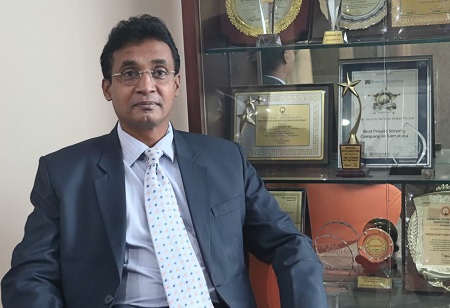Dr. K Ramesh, CEO, Quess Terrier, in an interaction with Sudhakar Singh, Editor, Industry Outlook, shares his views on the current surveillance and security market and how companies can adopt new technologies to secure their physical assets in a better way.
How do you see the current capability of manufacturing industry in terms of surveillance and security? Which technologies do you think have high potential for adoption in this segment and what measures need to be taken in that direction?
Manufacturing industry comprises companies ranging from traditional to the advanced ones. There is a wide differentiation between the traditional companies and the new companies which have come into being. The traditional companies are still operating primarily through their manpower, but the latest ones that are setting up new manufacturing setup are integrating manpower and technology.
In terms of technology adoption, we see an increasing alacrity among companies to adopt new technologies which is in contrast to the situation earlier when companies were reluctant to implement new technology. Today, there are a lot of companies who are asking for technology upgrade. Whether it is to upgrade the existing setup like replacing the analog cameras with the IP based cameras or to conduct video analytics, they are embracing the change rapidly. After the Covid-19 pandemic, many manufacturing setups are looking at thermal cameras and things like that.
Another area of focus is remote monitoring and command center operations. Traditionally, command center was never a concept in the manufacturing setup. But now we see an increasing trend where the command centers are being set up within the premises. So, these are a few trends in the manufacturing setup.
As a security solution provider, what do you think are the major challenges faced by manufacturers in maintaining security and how can those challenges be addressed?
If you look at the challenges, they can be classified primarily into two categories. One is the internal challenges and the other one is external challenges, particularly in the security and safety aspect.
The first type consists of cases like damage to property and assets done by the internal employees; for example, the recent violence at Wistron facility. So, that is one of the challenges that we are seeing. The other problem is internal theft which is also a major challenge that we come across in the manufacturing setup.
When it comes to external factors, they are prevalent in many of the manufacturing plants as they are set up mostly in the remote places. Sometimes the local villagers would come and stage a protest. Secondly, there are also a lot of theft and robbery issues, wherein the raw material can be stolen. Another case is when the raw material is moving from different places and coming to the wild while in transit, the theft happens. This is true also in the case of finished goods when it's going to the market or to the warehouse. So, that is another threat which we are seeing.
If you are able to use technology on a higher level, it can make a huge difference. To oversee the transit of finished goods as well as the raw materials, we can use GPS trackers, where we can track every bit. That is one thing. Secondly, for the insider threat, we should be using more of technology in terms of access control, through CCTV. We can integrate even the access control to the HRMS to make sure the attendance is done through facial recognition. So these are two technologies that we can really look forward to.
Could you elaborate on the new approaches for addressing the insider threats issue and how can technology be an enabler in that?
There are many insider threats. It is no longer sufficient to just frisk the personnel when they enter the facility. To mitigate the evolving risks, we have to be well prepared. There should be a constant surveillance of what exactly is happening within the facility. That is where we use technology where CCTV cameras are installed, and there is a command center. The command center could be set up in two ways - we can either have the command center within the premises or at a remote location. Then there are other incidences wherein the employee himself is involved in thefts of finished goods or even the raw materials. So, that is another threat that we should really look at.
Augmented reality is another technology which is helping in boosting physical security. How do you see its adoption and what role is 5G going to play?
5G is going to be a big term in terms of security per se. The technology we have today has some limitations in terms of integrating different portfolios into one. But with 5G coming in, the integration will become a lot easier, as we are using IoT based solutions. So, that will integrate multiple things and the whole process will become seamless.
Where do you see the surveillance and security domain in the near future?
We have taken a long time to adopt surveillance and remote monitoring. But the good news is that today the adoption level is much faster and higher. As far as Quess Terrier is concerned, we are fully focused on technology. We are completely geared up for the future. We have the resources where we can completely integrate multiple things into one. Our command center is capable of managing multiple media into one.
Secondly, we have excellent capability and expertise in designing, implementing and managing command centers for our customers; we have done numerous massive projects with them. For instance, at the Smart City project in Gujarat, we have done the complete CCTV camera installation across all the signals, and managed them. The command center has also been developed by us. So, that is where we have an excellent capability and we will build on that much more.
